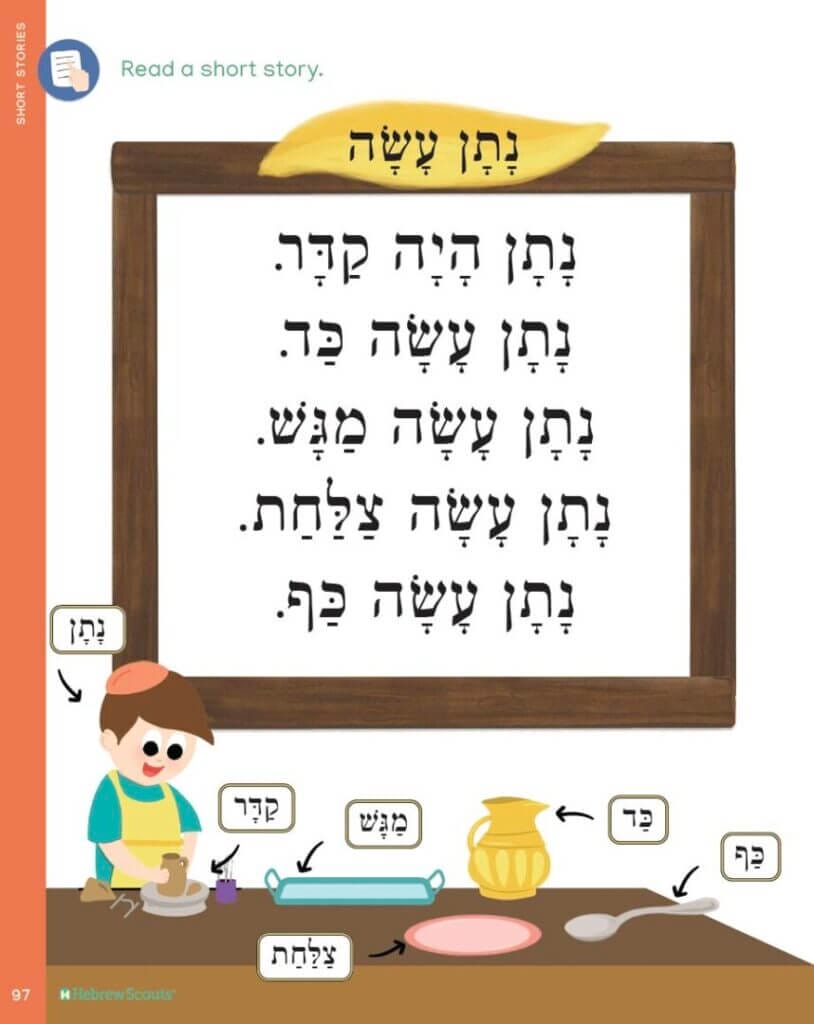Everyone agrees that vocabulary is foundational to English reading. However, not many people have come to this same conclusion for learning to read Hebrew as a second language. Yet, it may not be clear to everyone if and how word knowledge influences Hebrew reading fluency. Many worry that vocabulary learning may hinder or slow down decoding progress. Many people want to keep the status quo and to continue teaching decoding and comprehension in two separate silos. Hence, our intention is to demonstrate how vocabulary can catapult all reading skills. We are trying to persuade others to give vocabulary the attention it deserves.
In the year 1997, the US Congress was determined to figure out why the US was spending the most money per student on education, but we were ranking twenty fifth on our reading scores. Why were so many American children struggling to reach benchmarks? Looking for answers, Congress funded the National Reading Panel, a multidisciplinary team charged with figuring out which approaches work for teaching children how to read.
In 2000, their results were published and they identified five key concepts to be at the core of every effective reading instruction program: Phonemic Awareness, Phonics, Fluency, Vocabulary, and Comprehension. This knowledge has become mainstream across English literacy education approaches. In contrast, the foundational pillars are not yet widely accepted or applied for Hebrew literacy education. Currently, many Kriah educators primarily focus on phonemic awareness and decoding and expect children to decode quickly, even before they have acquired even a simple vocabulary. We hope to demonstrate the values of teaching Hebrew vocabulary as early as possible and the importance of weaving vocabulary in literacy instruction. We aren’t making this point solely based on the science of reading. We are confident about our statements because of over a decade of experiences helping many struggling students get over the mountain using these methods.
Why Is Vocabulary Important?
Reading a word entails processing the print on the page, interpreting the print into speech sounds, and then connecting the speech to ideas and concepts. The whole point of literacy is to communicate ideas through reading and writing. What is the purpose of going back and forth from symbols to sounds, symbols to sounds without deriving any meaning? It can make a child feel like a monotonous robot spitting out gibberish sounds. Even if a child is reading a wholesome text, they would not realize it, if the words do not YET represent any meaning. For some children this stage can last for years, and the consequences are that some children can disengage, give up and think that reading Hebrew is not for them.
Vocabulary for Engagement, Motivation & Stamina
Integer posuere erat a ante venenatis dapibus posuere velit aliquet. Donec sed odio dui. Curabitur blandit tempus porttitor. Curabitur blandit tempus porttitor. Cras justo odio, dapibus ac facilisis in, egestas eget quam. Nullam id dolor id nibh ultricies vehicula ut id elit. Integer posuere erat a ante venenatis dapibus posuere velit aliquet. Donec sed odio dui. Curabitur blandit tempus porttitor.
Did you read the above paragraph? Did you enjoy it? Do you wish you could read more? Probably not. You most likely did not derive any pleasure or meaning from reading it. This is how many children may feel when they have to read a language that they do not yet understand. They won’t even know if they are reading correctly or not. There is no way for them to self-monitor or self-correct.
Another consequence for children reading text beyond reach, they may learn that reading is a meaningless task. They may think that their only job is to get the sounds off the paper correctly and quickly. They may overlook the purpose of reading. They may not even realize that it is possible to derive meaning from a text and that they can connect with the author’s message. They just may make an assumption that reading Hebrew is boring and meaningless. But, it doesn’t have to be this way.
We can provide support for second language learners such as explicit vocabulary instruction and picture support. We can provide controlled texts with pre-taught vocabulary and language structures. We certainly can weave decoding and language learning and we should. And if children are able to understand what they are reading, they will receive intrinsic feedback that they are reading correctly and it will motivate them to keep on reading. Additionally, they will learn that using the code works.

Vocabulary for Comprehension
Bent lathe spindle, need ideas for repair: I have had a bit or an oops and the back of the spindle on our little Hitachi Seki lathe is bent. The diameter the the finger clock is on in the pic has about .05mm runout. I didn’t have time to check the runout on the flange. I will check it when I pull the cylinder for the power chuck off. The spindle motor also appears too integral to the spindle. Does anyone have any ideas how to fix this?
Even if we know some of the words of a text, but not most of the words, we can still run into trouble, and get bored or frustrated. We will likely quit unless there are external consequences, negative or positive. We wouldn’t choose to read the above paragraph. We would think it is irrelevant.
Vocabulary and comprehension is like a chicken to an egg. The more words we know, the better we can read. The better we read, the more we read. The more we read, the more words we’ll learn. Basically, vocabulary is foundational to reading and it catapults reading.
Vocabulary for Sight Words & Fluency
When a child reads through a word numerous times while attaching meaning to it, they can learn to recognize these words in an instant. When a child is able to immediately and instantly recognize a word, it is a “sight word.” They no longer need to decode it and therefore the word is read automatically. When they are able to do this with many words in connected text, fluency is developed. “Sight word development is the single biggest factor that influences a child’s reading fluency.” David Kilpatrick
Fluent reading is not about decoding quickly. Fluent reading requires rapid recognition of many words. It requires stamina, interest, comprehension and knowledge of language structures.
Kriah & Tehilim
Every time we utter a verse of Tefilah or Tehilim, it helps reaffirm our connection and faith to Hashem, our fellow Jews and ourselves. It helps us seek divine intervention, draw down blessings and salvation from heaven. Prayer provides inspiration, reassurance, courage and hope. It helps us realize our humility and our strength.
That being said, the language and content in these holy prayers may be lofty and abstract for our youngest learners. Many of these prayers include abstract poetry and parables beyond a young child’s reach. While we should plan to help children reach a level where they can decode and comprehend these holy verses, we should not be preparing them using these advanced texts. We should instead use simpler texts where the child can relate to the words and the content. This will help children move along from one level to the next, step-by-step, until they reach a point where they can read Tehillim with accuracy, fluency and some amount of comprehension/ Kavanah. All children can get to this point in good time if they read texts while using both decoding and language comprehension.

Chumash and Learning in Lashon Ha’kodesh
Torah is M’Lashon Haro’ah. Every letter, every word, every verse, every commandment and every story has a divine lesson for all of us. As parents and educators, it is our Mitzvah to teach children Torah and to empower them to become Torah scholars.
The Mishnah Avos 5:21 states that “At five years of age study the scripture” “בֶּן חָמֵשׁ שָׁנִים לַמִּקְרָא”
We should prepare children to learn Chumash as soon as possible. Aside from teaching our children how to decode, we should be teaching them the language of Torah so that they can actually relate intellectually. Learning to decode and learning language does not have to occur in two separate silos. We actually should be weaving them together as early as possible. It is more effective and it is more enjoyable. The earlier children start learning Lashon HaTorah, the more advanced their knowledge will be. The sooner we bring language into decoding, the sooner children will intrinsically enjoy reading Hebrew.
Double Dipping Kriah Practice
We made the argument for weaving vocabulary into Hebrew decoding instruction to improve reading and language abilities but we would like to point out one more practical benefit.
Children are anyways spending countless hours practicing Hebrew decoding. Instead of them just exercising how to convert text into speech sounds, they can also engage in language and content processing. In the same amount of time, two things can occur; the children can improve both their decoding skills and their language and content knowledge. It doesn’t take longer to read for meaning than it does to read a list of random words and pseudo-words.. Actually, we read faster when we understand what we are reading. So if you are curriculum mapping, you do not have to be concerned about not getting to a certain point at a certain time, you will get there in good time with many added benefits.

We can firmly state that vocabulary will catapult all Hebrew reading skills and learning abilities in good time. But most the most thing is that the children will have a love for learning. Imagine children loving Kriah. Imagine children wanting to do a Kriah activity because they are curious. Imagine.




